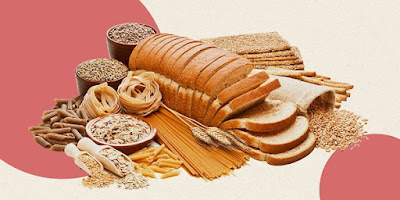Whole Grains in Your Diet by Sophia Cable (Guest Author)
 |
| Getty Images/TODAY |
Introduction: In the nutrition class I teach, students were asked to write a blog post on a nutrition topic. One of those students, Sophia Cable, wrote an interesting blog post on whole grains. Students were also asked to conduct some of their own “research” on their nutrition topic and that research is shared in her post. I welcome Sophia Cable as a guest author for this week’s blog post.
Grains are commonly thought of as bread, rice, pasta, and oats. Many people think that they should not be eating bread daily, or that they should never eat a plate of spaghetti. This is not true. Foods like this can be very healthy and beneficial to incorporate into your diet. The only thing is to make sure to choose the healthier options. You may be asking how can bread or pasta ever be healthy? The answer is simpler than you would think…choose whole grains.
To gather a little more information about what people think and know about whole grains I asked a couple of people a few questions. My first question was “What are the health benefits of eating whole grains vs. refined grains?” Overall, the answers from the participants were equal with their answers being that whole grains have more nutritional value, and some people simply said that they were not sure on the health benefits, or even the difference between the two grains. The second question I asked was “Do you have whole grain items in your diet? If yes, what are they?” The answers to this question were a little different. I had a couple people explain that they are not sure, and that they do not necessarily check the nutritional labels, or that they do not know how to tell when something is whole grain. The other participants told me that they try not to eat bread, pasta, crackers, etc., and someone told me that they buy brown bread, and they think it is whole grain bread. The last question I asked was “What foods do you think would be considered whole grain?” The answers to this question were a little better, and more knowledgeable than the other two. The answers included; brown rice, brown whole wheat bread, oatmeal, Cheerios, and someone mentioned bread with grains/ oats in it. After asking the participants my questions I realized that people do not exactly know what types of grains they should eat, and why they should be eating them.
Whole grains are grains that include all parts of the grain. To further this explanation, there are three parts to the grain kernel; germ, bran, and endosperm. Whole grains could be in whole form, or the grains could be ground into flour, but still keeping all three parts of the grain kernel during this grinding process.
 |
| Whole grains contain all 3 parts of the grain. |
There are many health benefits that come with choosing whole grain items instead of the processed, less nutritional foods. Whole grains have the complex carb – fiber, also the B vitamins (thiamin, riboflavin, niacin, folate), and many minerals (including iron, magnesium, and selenium). Fiber will help reduce your blood cholesterol, and lower your risk of heart disease. The vitamins mentioned play a big role in your metabolism and eating whole grains promotes a healthy immune system. Lastly, the minerals in these grains help with the transportation of oxygen in your blood, absorption, bone, cell, and immune system health. A few other benefits would include healthy digestion, and weight management. Eating whole grains before and during a pregnancy will help you have a better nutrition. It is recommended that at least 50% of your grains should be whole grains.
Now that you know the anatomy of the grain, nutritional value, and health benefits, it is time to change your diet. This information may be overwhelming, but there are many simple options to replace, or add to your diet. A few examples of whole grains are; barley, brown rice, buckwheat, cracked wheat, oatmeal, and popcorn. There are many options where whole grains could be grounded into the flour that makes bread, pasta, and crackers. Some popular snacks like Sun Chips, Goldfish crackers, and Ritz crackers offer whole grain options.
 |
| A whole grain chip. |

 |
| Choose Ritz crackers with some whole grain. |
It is as simple as ordering brown rice instead of white rice, or looking at the ingredient list on the back or side of your bread, or box of crackers. Look for the word, “whole” such as whole wheat, whole corn. The health benefits are worth it, and whole grains have many of the needed vitamins and minerals you may be missing in your current diet.
Sources: MyPlate, whole grains, Whole grains 101 Image Sources: Bread , Grain anatomy , Ritz Crackers



Comments
Post a Comment